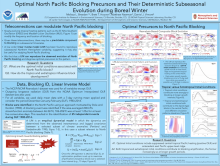Optimal North Pacific Blocking Precursors and Their Deterministic Subseasonal Evolution during Boreal Winter
Melissa
Breeden
Cooperative Institute for Research in Environmental Sciences, CU Boulder & NOAA Physical Sciences Laboratory
Poster
Atmospheric blocking is associated with sensible weather impacts such as anomalous precipitation and flooding, cold air outbreaks, and heat waves. Given the asymmetry in the persistence characteristics of anticyclones and cyclones, many studies have emphasized the role of nonlinearities in blocking onset and maintenance. However, previous studies have demonstrated that both linear and nonlinear dynamics can amplify blocks. In this paper the structure and evolution of North Pacific blocking on weekly time scales is investigated using two methods: statistical analysis not requiring linearity, and a linear inverse model (LIM) composed of tropical outgoing longwave radiation and extratropical streamfunction, which relies on purely linear (and linearly parameterized) dynamics. Both approaches produce a similar evolution of North Pacific blocking. Using the LIM, the optimal precursors to blocking are determined, which at a 14-day lead time include an upper-level east Pacific anticyclone and suppressed convection over the central tropical Pacific. The tropics and extratropics both contribute to the deterministic evolution of blocking, with the tropics acting on longer time scales but imposing a weaker response than that contributed by the extratropics. The tropical contribution was driven by La Niña–like conditions that produce a hemispheric anticyclonic anomaly, while the extratropical initial conditions produce an equivalent barotropic, wavelike pattern. The LIM’s ability to reproduce the observed blocking evolution suggests the predictable evolution of blocking on weekly time scales can be modeled in a linear frame-work, and that subseasonal forecasting of North Pacific blocking needs to consider both tropical and extratropical conditions.

Presentation file
Breeden_Melissa_blocking_poster.pdf
(3.62 MB)
Meeting homepage
